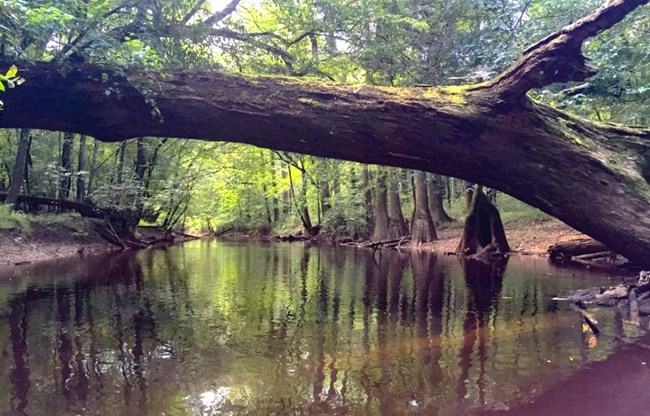Learn about NRCAs
The Natural Resource Condition Assessment (NRCA) Program provides framework, funding, and publishing support to parks to aid in the synthesis and documentation of natural resource conditions. Condition assessment reports are a tool to describe selected park resources, and record a snapshot of their current condition, identify trends, and identify potential or current threats and stressors. Understanding the condition and trend of natural resources is key for parks and NPS planners to appropriately prioritize and allocate stewardship resources.

NPS/Victoria Stauffenberg.
Congaree National Park is home to a highly diverse flora and fauna population, with 22 plant communities and dozens of species of trees in this unique old-growth bottomland forest. The major goals of park staff are to promote the natural function of the floodplain through preserving the wilderness areas and wetlands, and minimize the disturbance to natural features such as landforms, vegetation and wildlife habitat.
Traditional NRCA Report: 2019
In order to better understand the natural resources and processes within this park, a Natural Resource Condition Assessment report was written by park staff and published in 2019. Natural resources topics evaluated include:
- Human population surrounding the park |
- Surface water quality |
||||||||
- Park visitation |
- Vascular flora |
||||||||
- Surrounding land use and cover |
- Aquatic benthic macroinvertebrates |
||||||||
- Air quality |
- Fish |
||||||||
- Soundscape |
- Herpetofauna |
||||||||
- Lightscape (Dark Night Sky) |
- Birds |
||||||||
- Soils and streambank erosion |
- Mammals |
||||||||
- Groundwater supply |
- Other special management issues |
The sixteen resources were evaluated with available data to allow some level of quantitative or semiquantitative assessment. The overall condition of five resources was rated as good: visitation/humans in the park, aquatic benthic macroinvertebrates, fish, herpetofauna, and birds; four were evaluated to be in fair condition, or warranted moderate concern: air quality, soundscape, lightscape, and special management issues; and eight were in poor condition, or warranted significant concern: human population surrounding the park, surrounding land use/landcover, soil and streambank erosion, groundwater supply, surface water quality, vascular flora, and mammals. Nearly all of the natural resources in fair and poor condition were strongly influenced by external forces.
This report can function as a valuable resource for Congaree National Park staff and the Southeast Coast Network by enabling rapid communication to concerned citizens, policymakers in local, state, and federal governments, industries etc. about the pressing need to improve protection of the natural resources in this valuable park.
This report can function as a valuable resource for Congaree National Park staff and the Southeast Coast Network by enabling rapid communication to concerned citizens, policymakers in local, state, and federal governments, industries etc. about the pressing need to improve protection of the natural resources in this valuable park.
For other reports and natural resource datasets visit the NPS Data Store.
Source: NPS DataStore Collection 7765 (results presented are a subset). To search for additional information, visit the NPS DataStore.
Last updated: June 28, 2022
